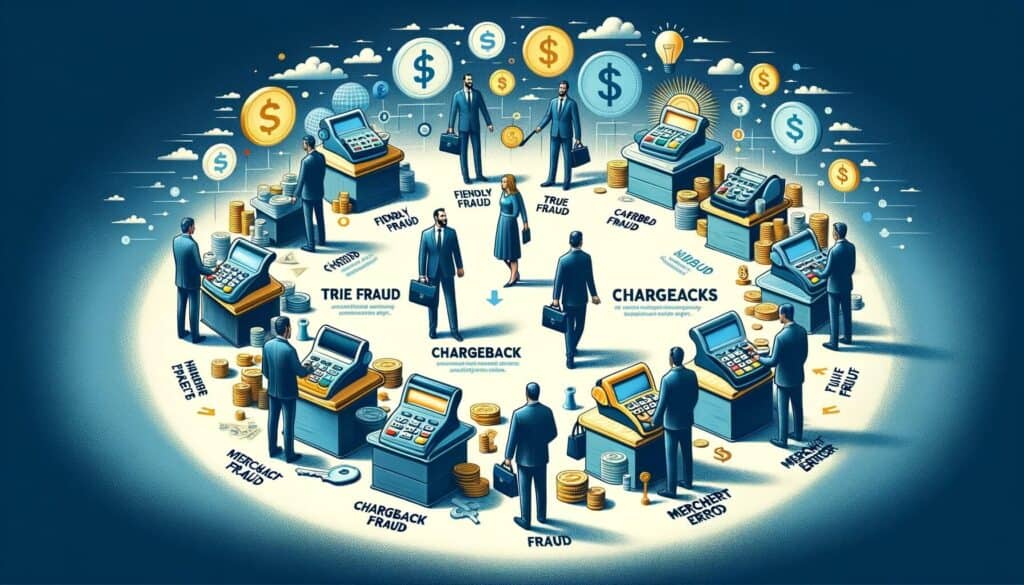
By Mollie Mills February 27, 2025
In today’s digital age, where online transactions have become the norm, chargebacks have emerged as a crucial aspect of the payment ecosystem. A chargeback is a process that allows consumers to dispute a transaction and request a refund from their bank or credit card issuer. It serves as a form of consumer protection, providing a safety net against fraudulent or unauthorized transactions. Understanding the basics of chargebacks is essential for both consumers and merchants to navigate the complex world of online payments.
A transaction dispute or chargeback occurs when a consumer contacts their bank or credit card issuer to dispute a transaction. The bank then initiates an investigation to determine the validity of the claim. If the investigation finds in favor of the consumer, the funds are returned to their account, and the merchant is debited for the disputed amount. transaction disputes can be initiated for various reasons, including unauthorized transactions, merchant errors, or instances of friendly fraud.
Types of Chargebacks: A Comprehensive Overview

It can be categorized into different types based on the reason for the dispute. Understanding these types is crucial for merchants to identify potential vulnerabilities in their payment processes and take appropriate measures to prevent chargebacks. Let’s explore the three main types in detail.
1. Unauthorized Transaction Chargebacks: Explained and Analyzed
Unauthorized transaction disputes occur when a consumer claims that they did not authorize or participate in a particular transaction. This type is often associated with cases of identity theft or credit card fraud. The consumer may argue that their card was stolen, their account was hacked, or they never received the goods or services they paid for.
To prevent unauthorized transaction chargebacks, merchants should implement robust security measures, such as two-factor authentication, to verify the identity of the cardholder. Additionally, maintaining a secure payment gateway and regularly monitoring transactions for suspicious activity can help detect and prevent fraudulent transactions.
2. Merchant Error Chargebacks: Causes and Prevention Strategies
Merchant error transaction disputes arise when a consumer disputes a transaction due to an error or mistake made by the merchant. This can include instances where the consumer was charged the wrong amount, received the wrong product, or experienced poor customer service. Merchant error transaction disputes can significantly impact a merchant’s reputation and financial stability.
To avoid merchant error chargebacks, merchants should ensure accurate and transparent billing practices. Clear communication with customers, prompt resolution of any issues or complaints, and a customer-centric approach can help prevent misunderstandings and disputes.
3. Friendly Fraud Chargebacks: Unveiling the Hidden Threat
Friendly fraud transaction disputes occur when a consumer intentionally disputes a legitimate transaction, often with the intention of obtaining a refund while retaining the purchased goods or services. This type of chargeback is deceptive and can be challenging for merchants to detect and prevent.
To mitigate the risk of friendly fraud transaction disputes, merchants should maintain detailed records of transactions, including customer information, IP addresses, and delivery confirmation. Implementing fraud detection tools and closely monitoring patterns of suspicious behavior can help identify potential cases of friendly fraud.
How to Dispute a Chargeback: Step-by-Step Guide

Disputing a chargeback can be a complex and time-consuming process for merchants. However, it is crucial to take proactive steps to protect their business and financial interests. Here is a step-by-step guide on how to dispute a transaction effectively.
1. Gather evidence: Collect all relevant documentation, including transaction records, customer communication, and proof of delivery or service.
2. Review the transaction dispute reason: Understand the reason provided by the consumer for the transaction dispute and assess its validity based on the evidence available.
3. Prepare a response: Craft a detailed and well-structured response that addresses each point raised in the transaction dispute reason. Provide clear and compelling evidence to support your case.
4. Submit the response: Submit the response to the bank or credit card issuer within the specified timeframe. Ensure that all required documentation is included and follow any specific submission guidelines provided.
5. Monitor the case: Keep track of the transaction dispute case and any additional requests for information or evidence from the bank or credit card issuer. Respond promptly and provide any requested documentation.
6. Seek professional assistance if needed: If the transaction dispute becomes complex or overwhelming, consider seeking professional assistance from a chargeback management service or legal counsel.
Chargeback Reversal: Strategies for Successful Retrieval

Successfully reversing a chargeback can be a significant win for merchants, as it not only recovers the disputed funds but also helps protect their reputation and reduce the risk of future transaction disputes. Here are some strategies that can increase the chances of a successful chargeback reversal.
1. Act promptly: Respond to the transaction dispute as soon as possible to demonstrate your commitment to resolving the issue and prevent it from escalating further.
2. Provide compelling evidence: Gather and present strong evidence that supports your case, such as transaction records, customer communication, and proof of delivery or service.
3. Maintain clear communication: Keep the lines of communication open with the consumer throughout the transaction dispute process. Promptly address any concerns or questions they may have.
4. Offer a refund or compromise: In some cases, offering a partial or full refund to the consumer can help resolve the dispute amicably and avoid the chargeback process altogether.
5. Collaborate with payment processors: Work closely with your payment processing system to understand their chargeback management policies and leverage their expertise to navigate the dispute resolution process.
The Chargeback Process: From Filing to Resolution

The chargeback process involves several stages, from the initial filing of a dispute to its resolution. Understanding each stage is crucial for both consumers and merchants to navigate the process effectively. Let’s explore the key stages of the chargeback process.
1. Filing a dispute: The consumer contacts their bank or credit card issuer to initiate a transaction dispute by providing details of the disputed transaction and the reason for the dispute.
2. Investigation: The bank or credit card issuer initiates an investigation to determine the validity of the transaction dispute claim. They may request additional information or evidence from both the consumer and the merchant.
3. Provisional credit: If the investigation finds in favor of the consumer, the bank or credit card issuer provides a provisional credit to the consumer’s account while the dispute is being resolved.
4. Merchant response: The merchant receives notification of the transaction dispute and has a specified timeframe to respond with evidence and documentation to support their case.
5. Arbitration: If the chargeback dispute remains unresolved after the initial investigation, it may proceed to arbitration, where an independent third party reviews the evidence and makes a final decision.
6. Resolution: The transaction dispute is either resolved in favor of the consumer, resulting in a debit to the merchant’s account, or in favor of the merchant, leading to the reversal of the provisional credit.
Real-Life Examples of Chargebacks: Lessons Learned
Examining real-life examples of chargebacks can provide valuable insights into the challenges faced by both consumers and merchants and the lessons learned from these experiences. Let’s explore a few notable examples.
1. Example 1: Unauthorized Transaction Chargeback
John, a consumer, notices several unauthorized transactions on his credit card statement. He contacts his bank to dispute the charges, claiming that his card was stolen. The bank investigates the transactions and finds evidence of fraudulent activity. John’s account is credited with the disputed amount, and the merchant is debited.
Lesson learned: Merchants should implement robust security measures to prevent unauthorized transactions, such as two-factor authentication and regular monitoring for suspicious activity.
2. Example 2: Merchant Error Chargeback
Sarah purchases a dress online but receives the wrong size. She contacts the merchant to request a refund or exchange, but the merchant fails to respond. Frustrated, Sarah initiates a transaction dispute, claiming that she received the wrong product. The bank investigates the case and finds evidence of poor customer service. Sarah’s account is credited, and the merchant is debited.
Lesson learned: Merchants should prioritize prompt and effective customer service to avoid merchant error chargebacks. Clear communication and timely resolution of customer complaints can help prevent disputes.
3. Example 3: Friendly Fraud Chargeback
Mark purchases a digital product online but later decides to dispute the charge, claiming that he never received the product. The bank investigates the case and finds evidence that Mark accessed and used the product. The chargeback is denied, and Mark’s account is not credited.
Lesson learned: Merchants should maintain detailed records of transactions and customer interactions to detect and prevent instances of friendly fraud. Implementing fraud detection tools and closely monitoring patterns of suspicious behavior can help identify potential cases.
FAQs
Q1. What is the difference between a chargeback and a refund?
Answer: A chargeback is a dispute initiated by the consumer with their bank or credit card issuer, while a refund is a voluntary return of funds by the merchant. Transaction disputes are typically used as a last resort when a consumer is unable to resolve a dispute directly with the merchant.
Q2. Can a transaction dispute be reversed?
Answer: Yes, a transaction dispute can be reversed if the merchant successfully disputes the claim and provides compelling evidence to support their case. However, the reversal process can be complex and time-consuming.
Q3. How long does the chargeback process take?
Answer: The chargeback process can vary in duration depending on various factors, including the complexity of the dispute, the responsiveness of the parties involved, and the specific policies of the bank or credit card issuer. It can range from a few weeks to several months.
Q4. Can chargebacks be prevented?
Answer: While chargebacks cannot be entirely prevented, merchants can take proactive measures to minimize their occurrence. Implementing robust security measures, maintaining clear communication with customers, and promptly resolving any issues or complaints can help prevent disputes.
Conclusion
Chargebacks play a crucial role in the modern payment ecosystem, providing consumers with a safety net against fraudulent or unauthorized transactions. Understanding the different types of chargebacks, such as unauthorized transaction chargebacks, merchant error transaction disputes, and friendly fraud chargebacks, is essential for both consumers and merchants to navigate the complex world of online payments.
Disputing a chargeback requires careful preparation, gathering compelling evidence, and prompt response to the bank or credit card issuer. Successful transaction dispute reversal strategies involve acting promptly, providing strong evidence, maintaining clear communication, and collaborating with payment processors.
The chargeback process involves several stages, from the initial filing of a dispute to its resolution. Real-life examples of transaction disputes provide valuable insights into the challenges faced by both consumers and merchants and the lessons learned from these experiences.
By understanding the basics of chargebacks, consumers can protect themselves from fraudulent transactions, while merchants can implement effective prevention strategies and navigate the transaction dispute process with confidence.